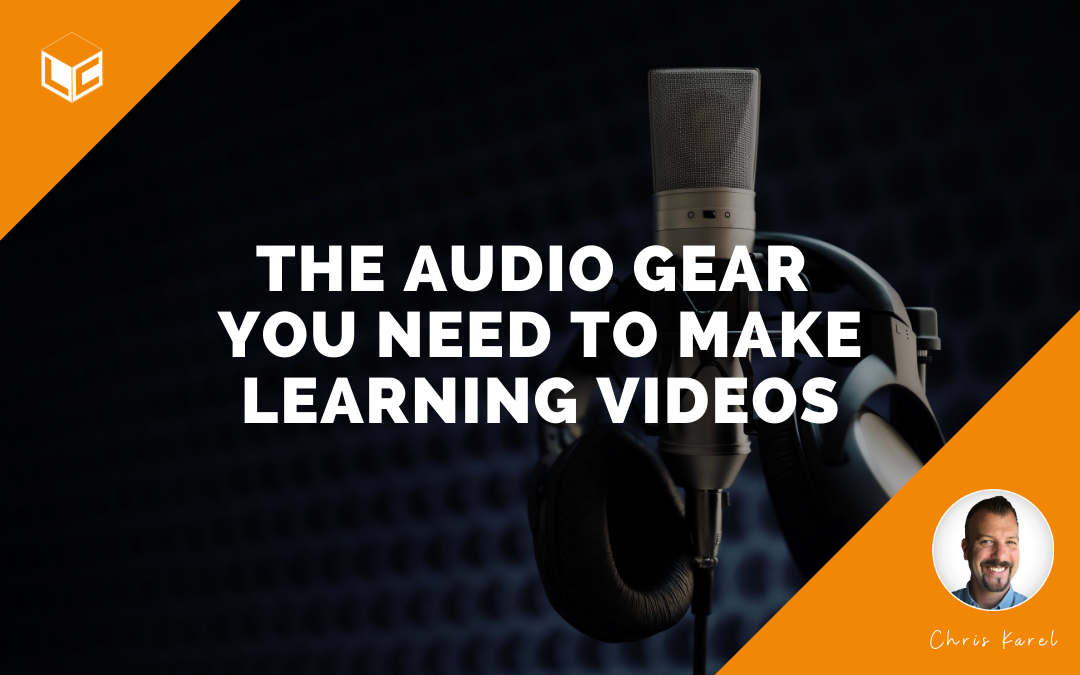I’m on a mission to help you make better videos for learning purposes. The gear you need to make learning videos exists in four categories: audio, lighting, camera, and computer. This post focuses exclusively on audio gear. Look for my other posts on the other gear types (coming soon).
If your budget is small, spend it on a microphone!
— Chris Karel
The audio gear you need to make learning videos
To make any kind of learning video you will need four types of microphones, quality headphones, storage cards, and cables. Because I teach DIY creators and professional vendors, I offer you my gear breakdown into four categories: minimum, essential, nice to have, and next level.
Pro-tip: Buy a microphone. Avoid using your built-in microphone unless you have no choice.
The single most important part of a learning video is the audio. If a learning video has bad audio, people will turn it off, fast forward, or worse, disengage and leave the course. Recording good audio is so critical because you only get one chance to get it right! Say this to yourself:
Good audio in, good audio out.
Despite the amazing advances in audio editing software, there is very little that can be done to fix bad audio. So, as you read about the audio gear I suggest you follow a professional process every time you record audio. Say it to yourself one more time just to let it sink in: Good audio in, good audio out.
After you purchase and learn how to use a good microphone, it only takes three steps to record professional audio every time.
- Control the environment
- Record and review
- Do multiple takes to get it right
Now let’s nerd out over some gear starting with the four types of microphones you need to make all six types of learning videos.
Microphones
Shotgun
A shotgun mic is great because it picks up only the sound you want! It limits the surrounding room sounds.
Learning about Electronics says, The advantage of shotgun microphones is they focus directly on the sound source in front and pick up the sound with high gain, while recording any other noises present in the environment very low, if at all, that may be to the sides or rear.
So, if you aim the shotgun mic at the invisible words coming from the speaker’s mouth, you’ll gather the best sound. Avoid aiming the shotgun mic directly at the speaker’s mouth. The shotgun mic does not really pick up unwanted sounds in the room, which is good.
MINIMUM – ESSENTIAL
If you are doing the recording yourself and need to use a cellphone or a setup that does not allow the use of a shotgun mic, C-stand, or audio cables that plug into a camera or a field recorder, then you can use a compact shotgun mic like the one from Rode. Rode VideoMicro Compact On-Camera Microphone – $50-80


NEXT LEVEL
On a traditional video shoot with a video crew, I would use a shotgun microphone on a C-stand similar to the image seen below.
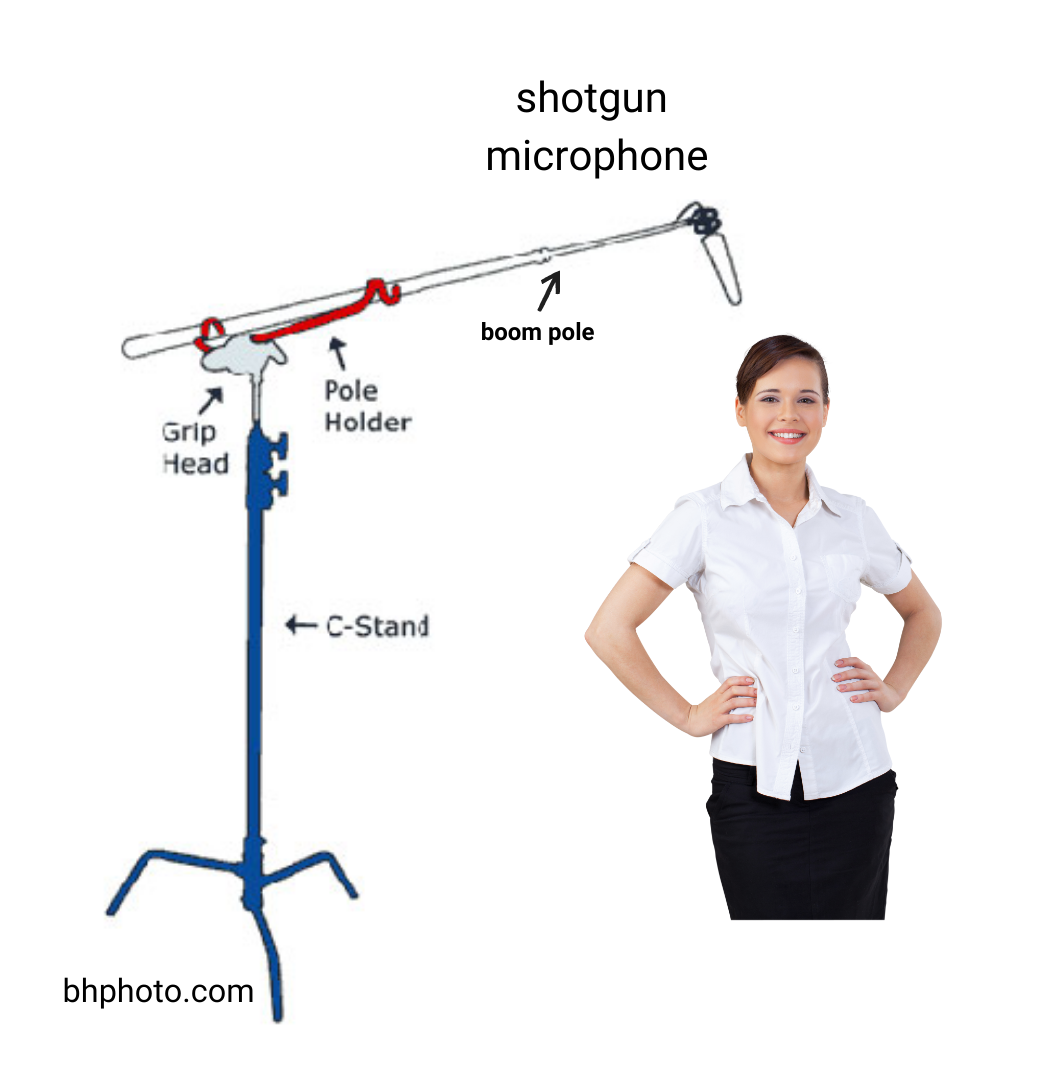
You may want to try a kit like the Sennheiser MKE 600 Video, Cinema and Broadcasting kit for about $420. The inclusion of the boom pole and windscreens make this kit a great addition to your learning video gear.

Lavalier
Also known as lav, lapel mic, clip mic, body mic, collar mic, neck mic or personal mic), this small microphone is common in television, theater, public speaking, and learning videos where hands-free mobility is important (Wikipedia).

Whichever lav you buy, practice putting it on people. Your goal should be to hide the mic on a collar, tie, or other clothing so that you can’t see it. Be careful when you wire someone with a lav. Make sure the person can move freely without causing feedback from their clothing rustling up against the mic.
Sennheiser says it best: As they are supposed to blend in with your wardrobe, lavalier microphones must be small, unobtrusive, close to invisible. Their attachment to clothing has to be quick and easy and durable. On the sonic side a good lavalier microphone picks up nothing more than your voice. Helping you to be heard without effort. Enabling you to speak in a way that is pleasant for you as well as for your audience.
The lav mic has three major parts: a bodypack, portable receiver, and a microphone. Of course, you’ll need a line to get from the receiver into your camera, and batteries too.
MINIMUM
The BOYA Lavalier Microphone – for cellphones, is priced around $25 and is a good entry-level lav mic that plugs directly into your mobile phone or tablet.

ESSENTIAL
Rode makes great lav mics, too. Unfortunately, you have to buy the microphone and the transmitter/receiver pack separately. The Rode smartLav+ microphone is about $80 and the Rode Wireless Go – Transmitter and Receiver is about $200.
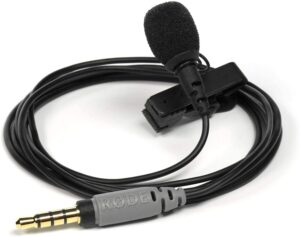
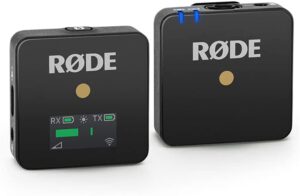
NEXT LEVEL
When I became a professional video producer, I started using industry-standard Sennheiser Lavalier Mics. If you want next level lavs, I suggest Sennheiser Pro Audio Ew 100 Portable Wireless Microphone System – it’s around $600.
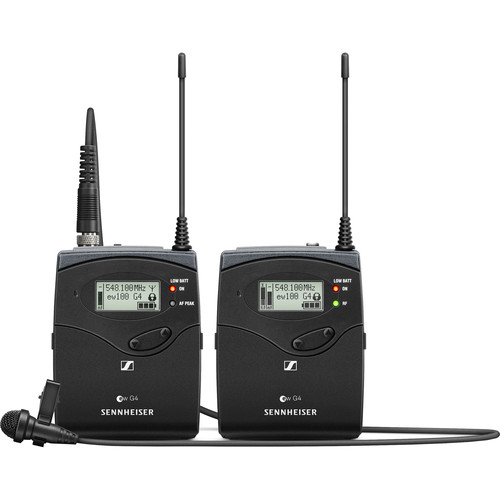
VO Microphone
Choosing the right microphone for VO (voiceover) work can be overwhelming because of the wide variety of choices. In addition to purchasing a microphone, you will need some type of stabilization and audio cable to connect it to your mixer and/or your computer.
MINIMUM
Newer models of iPhones (and Android phones) have really good microphones built-in. It is possible to create an excellent voiceover with the iPhone if you take care to record in a space that is suitable for audio recording. But, this is not ideal for learning video work. You can, however, use a built-in mobile phone mic for marketing purposes.
ESSENTIAL
I use the Audio-Technica AT2020 Cardioid Condenser Studio XLR Microphone. It’s around a hundo ($100) and is used by several professional voice artists that I’ve worked with over the years. It is quality enough to record amazingly good voiceovers when used with the proper sound absorption and dampening in the recording area. The AT2020 will require a mixer that can connect to your computer. Please contact me if you decide to go this route. It will provide amazing results but will require additional guidance.
For another option, the Blue Yeti is also an essential mic because it can plug and play directly into your computer.
NEXT LEVEL
Above my use, but highly recommended by VO professionals, the Neumann TLM-102 Studio Condenser Microphone tops the charts. It’s around $700.
Wired Headphones
MINIMUM
Use the wired earbuds that came with your phone. DO NOT USE Bluetooth headphones like AirPods or Galaxy Buds. The wireless signal will not give you a true sound from your recording.
According to the SoundGuys: Bluetooth is pretty terrible, at least when it comes to sound quality. While it’s definitely improved since its inception and most people won’t hear a difference, our testing shows that wired is still king when it comes to quality.
ESSENTIAL
If you are going to just use headphones to monitor your learning videos or your audio recordings then I suggest the Audio-Technica ATH-M30x Professional Studio Monitor Headphones for about $70.

However, I purchased the highly rated SteelSeries Arctis 5 – RGB Illuminated Gaming Headset – for about $99 because it comes with a great microphone that slides in and out of one of the ear coverings. The headset is perfect for video calls and even saving the occasional galaxy while Steaming on Discord.

NEXT LEVEL
If you want to buy a set of the best studio monitors available, then I suggest the Sennheiser HD 650 Open Back Professional Headphone for about $400.

Live Event Microphones
If you are providing live video to an audience you need a microphone that is not built-into your computer. Using a headset will create better audio than any built-in computer microphone. For zero budget, your audio will be better if you use the headphones that came with your phone, they are still better than an onboard mic. However, if you spend a lot of time making video calls or interacting on live online events, then a dedicated headset or microphone is required to make you sound professional.
MINIMUM
For around $30, I’ve used the Logitech Over-The-Head Wireless Headset H600. If you are using them daily, these will start to become uncomfortable. Buyer Beware!
As referenced earlier, you should follow the SoundGuys advice with Live Event microphones too. AirPods or Sound Buds should not be a part of your live event setup.
If you have a quality webcam like the Logitech C920 Hd Pro Webcam Black for $140, it has a decent microphone onboard that will gather good sound. Remember, you will still need headphones, earbuds or directional speakers to avoid creating a feedback loop.
ESSENTIAL
Here is a place you can use my suggestion and purchase the highly-rated SteelSeries Arctis 5 – RGB Illuminated Gaming Headset – for about $99 because it comes with a great microphone that slides in and out of one of the ear coverings. Buying this for live events allows you to save money with a multi-purpose tool. Buyer Act Now!

7 out of 10 elearning experts I asked about microphones said they had the Blue Yeti Microphone (around $160) The Blue Yeti offers you the ability to change the pick-up pattern of the mic. The Blue Yeti is a solid choice to use for live events and VO work. Similar to the SteelSeries headset, this is a great multi-purpose tool.

NEXT LEVEL
There are pricier setups that include multi-hundred dollar microphones, mixing boards, pre-amps, software, etc. But in order to get the skills to pay the bills, start with a price point that fits your budget and practice. Level up your gear as your skills improve.
Helpful Links
If you are like me and are doing a deep dive into researching different models and price points, I suggest heading over to Scott Winstead’s post 17 Quality Voice Over Microphones for a Home Recording Studio.
Learn now:
Check out the ever-awesome Tim Slade’s, How To Record High-Quality Audio For E-learning
There’s also more great info from Scott Winstead with, How to Set Up a Voice Over Studio in Your Home for Various Budgets.
Summary
A microphone and a pair of headphones are the only audio gear you need to make learning videos. In a perfect world, you should own three microphones: shotgun, lavalier, and VO (or studio). The headphones you choose are truly your preference, but they need to be wired. You can save some money by purchasing high-quality headphones that can also be used as a headset/mic combo for video calls. Whatever gear you buy, remember this pro-tip: Good audio in, good audio out.
Join my learning pals
What microphones have you used in your learning videos and how well did they work? Share your voice with me.
Did you like what you read? Join my learning pals. Please subscribe to my newsletter to receive free learning resources delivered to your inbox every two weeks.
THE END

